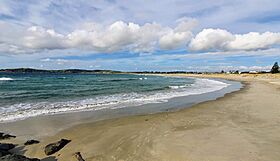Ōmaha facts for kids
Quick facts for kids
Ōmaha
|
|
|---|---|

Ōmaha Beach in mid-summer
|
|
| Country | New Zealand |
| Region | Auckland Region |
| Ward | Rodney ward |
| Community board | Rodney Local Board |
| Subdivision | Warkworth subdivision |
| Electorates |
|
| Area | |
| • Total | 4.85 km2 (1.87 sq mi) |
| Population
(June 2023)
|
|
| • Total | 800 |
| • Density | 165/km2 (427/sq mi) |
Ōmaha is a small, sunny beach town in the Auckland Region of New Zealand. It's about 75 kilometers north of central Auckland. Ōmaha sits on a narrow strip of sand, called a sandspit. This sandspit connects to the Tāwharanui Peninsula and separates the Whangateau Harbour from Ōmaha Bay. The closest bigger town is Warkworth, which is about 17 kilometers southwest.
History of Ōmaha
Ōmaha was once a settlement for the Marutūāhu people. In 1841, the land was bought by the Crown, which means the New Zealand government. Early European settlers first lived at a place called Sandspit.
The Māori name Ōmaha means 'bountiful food' or 'great resources'. This shows that the area was rich in food and supplies. Interestingly, the nearby town of Leigh was historically called Ōmaha by Māori. The beach we know as Ōmaha Beach was once called Mangatawhiri by the Ngāti Manuhiri tribe.
Ōmaha started to grow a lot in the 1970s. A company built a bridge to Ōmaha, which made it easier to get there. They then divided the land into smaller plots and built many houses.
To stop the beach from wearing away (erosion), a wooden barrier was built. But in July 1978, a big storm destroyed this barrier. It also damaged some houses right on the beach. To fix the erosion and stop flooding during high tides, three special walls called groynes were built. These groynes help to change the direction of ocean currents away from Ōmaha. Also, the harbor was dredged, meaning sand was dug up from the bottom and moved to the beach.
After this work to protect the coastline, more building permits were allowed. However, most new houses had to be built slightly higher off the ground to protect them from future floods.
Geography and Nature
The sandspit that Ōmaha sits on was formed a very long time ago, about 5,000 to 6,000 years ago, during the last ice age. The sand on the beach is mostly made of quartz, which gives Ōmaha its beautiful "white" look.
The three artificial groynes at the northern end of the sandspit help to collect sand. This sand is moved along the coast by currents, a process called longshore drift. Over the last 20 years, the local council has planted different types of plants to help keep the sand dunes stable. These plants include Spinifex, pingao, iceplant, and marram grass.
Ōmaha Spit is also a very important place for a special bird called the New Zealand dotterel. It's a "significant breeding site" for this endangered bird. Because of this, the Omaha Shorebird Protection Trust was started in 2009. Their job is to keep an eye on the dotterel population in Ōmaha. The Trust raised $162,000, and in 2012, they built a special fence. This fence helps protect the birds, their chicks, and their eggs from predators like cats, rats, stoats, weasels, and hedgehogs.
People and Population
In the early 1980s, fewer than 100 people lived in Ōmaha. By the early 1990s, the population had grown to 300.
Statistics New Zealand describes Ōmaha as a rural settlement. It covers about 4.85 square kilometers. As of 2018, the estimated population was 753 people. This means there were about 155 people living in each square kilometer. Ōmaha is part of a larger area called the Tāwharanui Peninsula.
| Historical population | ||
|---|---|---|
| Year | Pop. | ±% p.a. |
| 2006 | 420 | — |
| 2013 | 624 | +5.82% |
| 2018 | 753 | +3.83% |
| 2023 | 744 | −0.24% |
In the 2023 New Zealand census, Ōmaha had 744 people. This was a small decrease from 2018 but a good increase since 2013. There were more females (405) than males (339) living in 318 homes. The average age of people in Ōmaha was 60.7 years, which is older than the national average of 38.1 years.
About 11.7% of the people were under 15 years old. 8.1% were aged 15 to 29. The largest groups were those aged 30 to 64 (39.9%) and those 65 or older (40.3%).
Most people in Ōmaha (96.4%) identified as European (Pākehā). Some also identified as Māori (6.0%), Pasifika (2.0%), or Asian (0.8%). English was spoken by almost everyone (99.2%). About 17.3% of the people were born outside New Zealand.
When it came to religion, 34.7% of people identified as Christian. More than half (56.5%) said they had no religion.
Many adults in Ōmaha have good education. About 21.5% of people aged 15 and over had a university degree. Another 58.0% had a certificate or diploma after high school. The average income was $45,100. About 34.2% of adults worked full-time, and 16.9% worked part-time.
Community Life
Ōmaha is a popular spot, even for well-known people. For example, John Key, who used to be the Prime Minister of New Zealand, has owned property here for over 20 years. Famous fashion designer Trelise Cooper and former TV presenter Louise Wallace also have homes in Ōmaha.
The town has many facilities for fun and sports. There's a boat ramp for launching boats, a surf club for those who love the waves, and an 18-hole golf course. You can also find tennis courts, a bowling club, and playgrounds for children.
Since 2018, Ōmaha has had bus services, with 7 buses a day connecting it to Warkworth.
Images for kids





